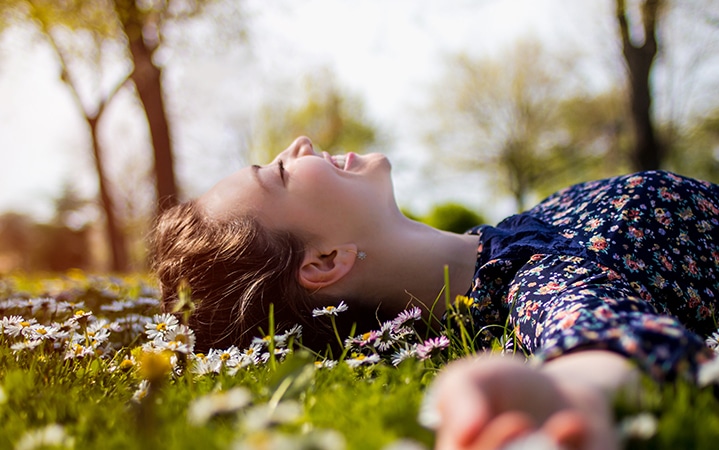
Hayfever & Allergy Symptoms, Causes & Relief
Hayfever & Allergy Symptoms
Did you know hayfever affects around 1 in 5 people in Australia?* Find out how.
View RangeWhat is hayfever?
Hayfever, or allergic rhinitis as it’s known in medical circles, is neither caused by hay nor results in a fever. Rather, hayfever describes the sneezing and itchy nose and eyes that affect up to 1 in 5 Australians* after they come into contact with allergens in their environment . But what are these environmental allergens and how do they trigger hayfever symptoms?
What causes hayfever?
Hayfever symptoms are caused by exposure to allergens – the name given to anything that triggers an allergic reaction. For people who are sensitive to an allergen, it can make their body’s natural defence system trigger what’s called an immune response that causes inflammation inside their nose and eyes.
So, when exposed to environmental allergens, people with hayfever usually experience the following symptoms:
● Itchy, runny nose
● Sneezing
● Itchy, watery eyes
● Blocked nose
How to tell if it’s hayfever, allergies, or a cold
Because hayfever, allergies, and colds all share a lot of similar symptoms, sometimes it can get a little tricky figuring out what’s behind your sniffles. Hayfever and allergies are your body’s response to allergen exposure and often cause an itchy nose and itchy, watery eyes. On the other hand, colds are mostly caused by a viral infection and don’t usually lead to an itchy nose or eyes. Here is a handy table that can help you determine whether your symptoms are from hayfever, allergies, or a cold.
| If you experience: | It could be: | ||
| Hayfever | Allergy | Cold | |
| Itchy nose | ✓ | ✓ | |
| Itchy, watery eyes | ✓ | ✓ | |
| Runny nose | ✓ | ✓ | ✓ |
| Blocked nose | ✓ | ✓ | |
| Sneezing | ✓ | ✓ | |
| Snoring | ✓ | ||
| Aches and pains | ✓ | ||
| Cough | ✓ | ||
| Headache | ✓ | ||
| Sore throat | ✓ | ✓ | |
| Hives | ✓ | ||
Are there specific hayfever seasons?
For many people, hayfever symptoms are closely tied to the seasons – that early morning sneezing fit or those itchy, watery eyes often mark the start of spring time or summer. This is because some of the most common hayfever triggers are pollens produced by trees, weeds, and grasses – which often occurs during the warmer months of the year.
It’s a little more complex than just seasons though – where you live in Australia affects the type and amount of pollen and grass, when pollen is produced, and how windy it gets. This means that when hayfever hits and how long your symptoms last can be different depending on what part of the country you’re in.
Hayfever vs allergies: same triggers?
While hayfever is often used to describe the seasonal allergies associated with pollens and grasses that are only present at certain times of year, it’s also caused by other environmental allergens. Things that occur in our homes and are present all year round, such as dust mites, mould , or pet dander (allergens in the skin and saliva of cats and dogs), can cause allergic rhinitis symptoms .
These hayfever triggers are different, but they work in your body in the same way. When exposed to an allergen, your body launches an immune response – releasing a chemical called histamine that results in inflammation and your hayfever symptoms. That’s why medications called antihistamines are often used to treat hayfever : antihistamines block how your body reacts to the release of histamine during the allergic reaction .
When hayfever hits, try the DEMAZIN Hayfever range!
View RangeFrequently asked questions about hayfever causes
Hayfever (allergic rhinitis) affects around 1 in 5 Australians, although it is more common in adults than it is in children. It affects men and women in similar numbers. *
Hayfever describes the symptoms of allergic rhinitis caused by any allergen, while seasonal allergies refer more specifically to the hayfever triggered by pollens present in the air only at certain times of the year.
Hayfever is triggered by environmental allergens, including pollens from trees, weeds, and grasses, as well as dust mites, mould spores, and pet dander.
Yes – symptoms of hayfever can last as long as the person continues to be exposed to the allergen that’s causing the reaction, which could mean a few months during pollen season or even all year for some allergens.
*Australian Institute of Health and Welfare 2020. Allergic rhinitis (‘hay fever’). Cat. no. PHE257. Canberra: AIWH.
AU-2022-08-0031